
Set Description
Dealing with China - US Trade Dollars
(Click on Thumbnail to Enlarge)
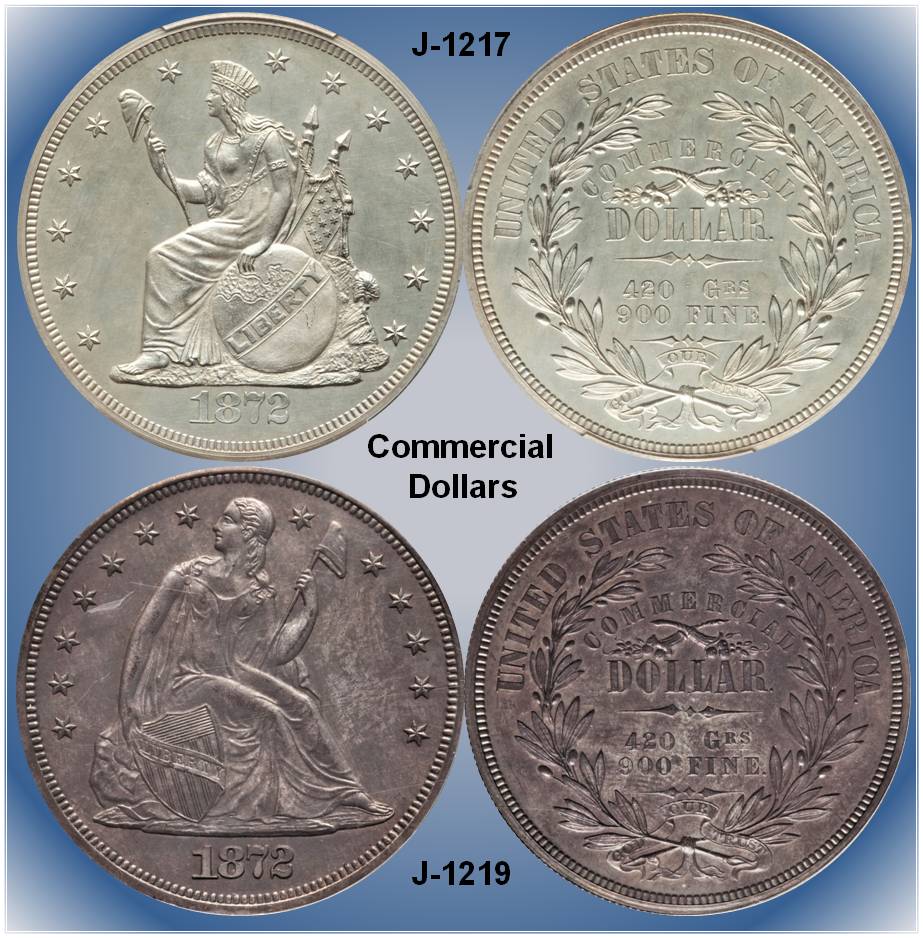
In anticipation of the Coinage Act of 1873, trial pieces were developed to address trade with Asia and specifically China. China did not value the country of origin of the currency but the value of the silver pieces thus the rational for the "420 GRS 900 FINE" notation on the reverses. The 1st commercial patterns were struck in 1871 and were label "COMMERCIAL DOLLAR" - the fore runner to the term "TRADE DOLLAR". I collected several examples of the commercial dollars struck in 1872. Two (2) notable obverse types were produced - one being Longacre's Seated Indian Princess and the second obverse that of the traditional Liberty Seated die.
Overall, this Pattern set establish to replicate the 6 piece Pattern Set of 1873 Trade dollars that were assembled and sold in sets of 6. These 6 patterns, Miss Liberty faces to our left that may coincidentally agree with the rational of the Official Trade dollar when she is looking West towards CHINA
Click here Return to Mania's Master Pattern Listing
Mania's US Patterns- WHAT U.S. COINAGE COULD HAVE BEEN
-------------------------------------------------------------------------------------------------------------------------------
Set Goals
Replicate the 6 US Trade Dollar Patterns that the US mint assemble in 1873 and sold in sets for $30 along with the other shorter theme Commercial Dollars.
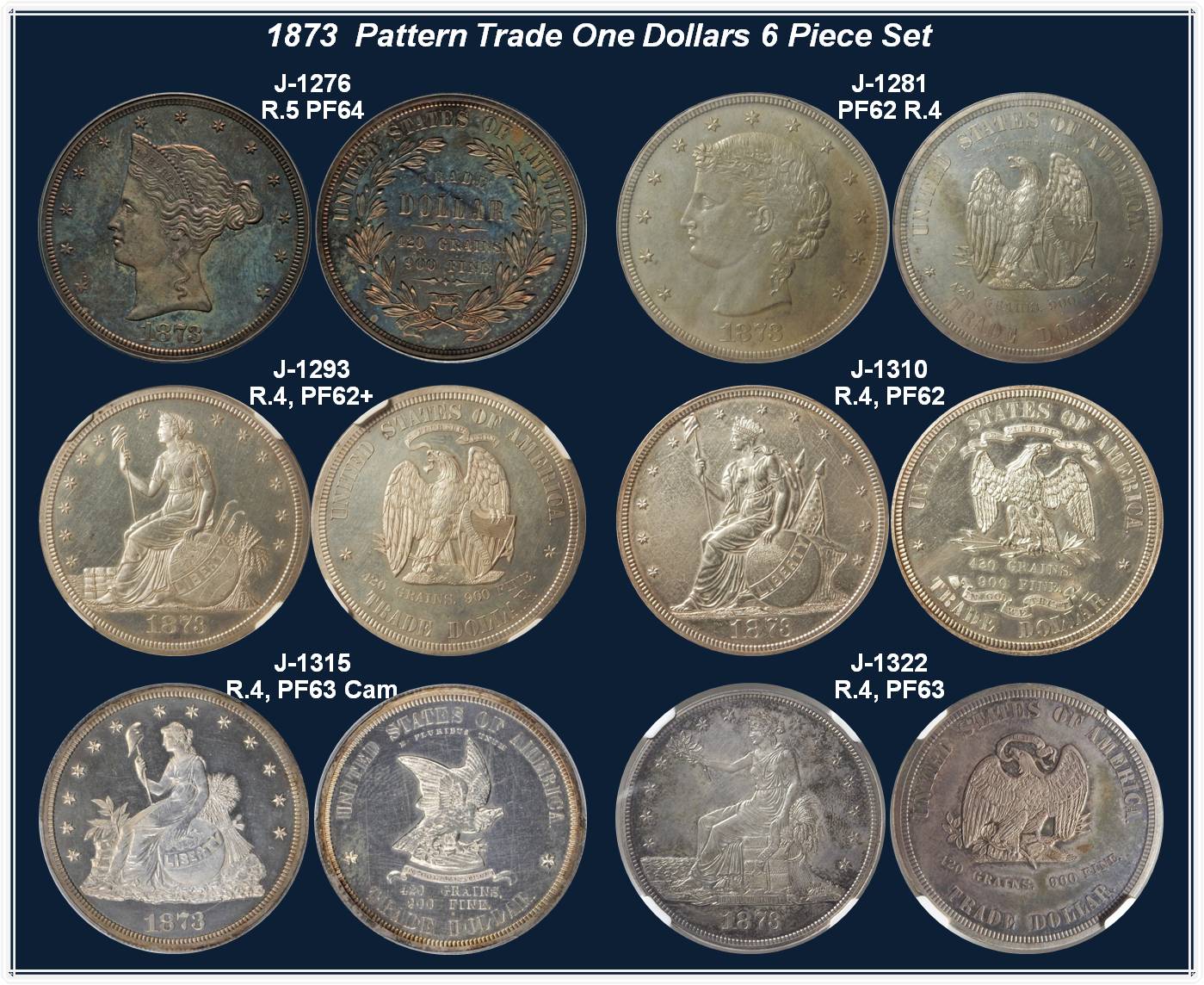
| | | | | | |
| | | | | | |
|
View Coin
| Indian Princess
Commercial Dollar
In Silver |
United States
|
T$1 1872 J-1214
|
PCGS PF 63
|

1872 $1 Commercial
Judd-1214, Pollock-1355
Rarity: High R.7
Ex: Eliasberg-Simpson
Struck in silver with a reeded edge
Obverse: Liberty is seated on a world globe, inscribed LIBERTY, facing left, and wearing an Indian headdress. The date 1872 is below and 13 stars surround the top. Liberty is holding a pole topped by a Phrygian cap in her right hand and her left hand is along her side resting on the globe. Two flags flank her with one displaying 13 stars.
Reverse: The denomination “COMMERCIAL DOLLAR” with the specific weight, 420 GRS, and the quality ,900 FINE, are inscribed in the center of a wreath of olive branches. The motto “GOD OUR TRUST” in inscribes on a scroll at the bottom and UNITED STATES OF AMERICA is at the top rim. Two cornucopias are crisscross between the words COMMERICAL and DOLLAR
Comment:
This Select proof is well-struck and lightly toned in rose hues. A few scattered ticks and hairlines are trivial but account for the grade.
This the William Barber's lower-relief adaptation of James B. Longacre's Indian Princess design, used posthumously after Longacre's death on January 1, 1869. There were a few differences one being only 13 stars in the flag vs. Longarce’s 22. Of note is that about ½ of the stars are double punched and some being significantly off center.
Per Bower's 1996 catalog the piece Weight is 419.9 grains and Diameter is 1.490 inches.
Provenance:
Ex: Ex: H.P.Smith (S.H. Chapman 5/1906), Clapp, Louis Eliasberg SR., Bowers and Merena May 1996 / Lot#292 (Sold $7,920); Bob R. Simpson Heritage Nov 2020 / Lot #3219
|

|
|
View Coin
| Indian Princess
Commercial Dollar
In Copper |
United States
|
T$1 1872 J-1216
|
NGC PF 65 BN
|
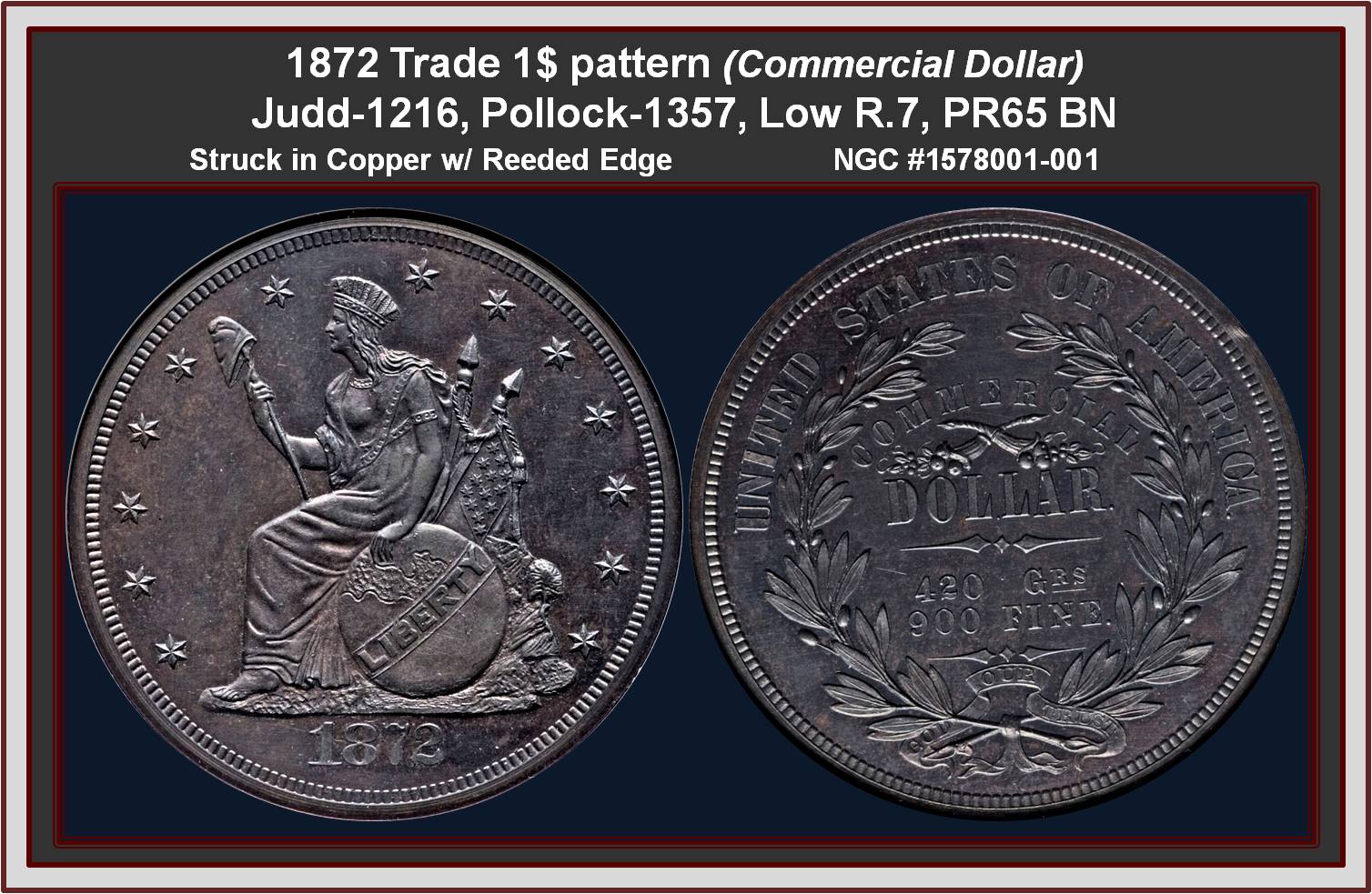
1872 $1 Commercial
Judd-1216, Pollock-1357
Rarity: Low R.7 PF65BN
Struck in copper with a reeded edge.
Obverse: Liberty is seated on a world globe, inscribed LIBERTY, facing left, and wearing an Indian headdress. The date 1872 is below and 13 stars surround the top. Liberty is holding a pole topped by a Phrygian cap in her right hand and her left hand is along her side resting on the globe. Two flags flank her with one displaying 13 stars.
Reverse: The reverse has UNITED STATES OF AMERICA above an olive wreath. GOD OUR TRUST is below the wreath on a scroll, and within the wreath are the legends COMMERCIAL / DOLLAR / 420 GRs / 900 FINE Two cornucopias are crisscross between the words COMMERCIAL and DOLLAR
Comment:. USPatterns.com estimates that about a half dozen copper strikings are known today. Deep blue-gray patina barely covers the underlying mint red. Fully struck throughout.
This the William Barber's lower-relief adaptation of James B. Longacre's Indian Princess design, used posthumously after Longacre's death on January 1, 1869. There were a few differences one being only 13 stars in the flag vs. Longarce’s 22. Of note is that about ½ of the stars are double punched and some being significantly off center.
Provenance/Appearances:
Private Transaction Prior: From The Siegel Collection,. Heritage April 2017 CSNS Chicago / Lot #5112 ,
Possible Bowers & Merena Jan 1997 (Rarities Sale) / Lot #479;
Possible Bowers & Merena Nov 1995 (Rogers Fred and Peter Ward, M.D. Collections) / Lot #2326
--------------------------------------------------------------------------------
I like to add the following - Numismatic Reflections by Q. David Bowers
The Commercial dollars are very special patterns. They are the work of John Jay Knox, himself a numismatist, who crafted the wording for the Coinage Act of 1873. This was endorsed by Congress and passed easily. Some years later, when the price of silver dropped on world markets, and western mining interests suffered because Uncle Sam wasn't buying enough metal in quantity to support the market, the bill was called the "Crime of 1873." But, careful reading of it will show that it was well thought out. ��Not to worry, some years later in 1878 the western mining interests triumphed, influenced Congress to enact the boondoggle Bland-Allison Act, and the government began buying millions of ounces of unwanted silver metal each year and coin them into what we now know as Morgan dollars. There was no commercial need for dollars at the time, as they circulated only in a few places and not in quantity. Accordingly, hundreds of millions of them piled up in Treasury vaults. This turned out to be an absolute delight for numismatists of generations later, as now Mint State Morgan dollars are very plentiful, at least for the majority of issues. Incidentally, the very same thing is happening today with Presidential dollars and Sacagawea dollars-zillions of them are being minted, they are not seen in circulation, and somewhere vaults must be bulging with them!
|

|
|
View Coin
| Liberty Seated
Commercial Dollar |
United States
|
T$1 1872 J-1219
|
PCGS PF 62
|

1872 1$ Commercial Dollar
Judd-1219, Pollock-1360
Rarity: Low R.7; PR62
Struck in silver with a reeded edge
Obverse: The obverse is the regular design for the Seated Liberty dollar.
Reverse: The reverse has a laurel wreath with UNITED STATES OF AMERICA around. The wreath stems are tied by a bow, and intertwined with a ribbon inscribed GOD OUR TRUST. Inside, COMMERCIAL and DOLLAR are separated by a cornucopia with 420 GRS 900 FINE on two lines below.
Comment:
About 15 examples of this pattern variety are known, and at least three of those are held in museums. Steel-gray toning embraces both sides, though areas of lighter straw-gold persist, especially on the reverse. Well struck and unblemished with eye appeal that exceeds the numerical grade.
Reciting on of the many Numismatic Reflections by Q. David Bowers
The Commercial dollars are very special patterns. They are the work of John Jay Knox, himself a numismatist, who crafted the wording for the Coinage Act of 1873. This was endorsed by Congress and passed easily. Some years later, when the price of silver dropped on world markets, and western mining interests suffered because the government wasn't buying enough metal in quantity to support the market, the bill was called the "Crime of 1873." But, careful reading of it will show that it was well thought out. ��Some years later in 1878 the western mining interests triumphed, influenced Congress to enact the Bland-Allison Act, and the government began buying millions of ounces of unwanted silver metal each year and coin them into what we now know as Morgan dollars. There was no commercial need for dollars at the time, as they circulated only in a few places and not in quantity. Accordingly, hundreds of millions of them piled up in Treasury vaults.
Provenance/ Appearances:
From Heritage Jan 2021 FUN Signature Auction / Lot #4908; Prior
- Ex: Heritage Aug 2007 Milwaukee ANA /Lot #2745;
- Stacks Nov 2007 Amherst & Waccabuc Collections Sale /Lot #1160;
- Bowers & Merena Nov 2001 (The Tree Many Feathers Collection) Lot #176 ($4000),
- Heritage Jan 2000 Fun Lot #762 (Passed)
- Heritage Mar 1999 (Sacramento ANA) Lot #5730 (Pass)
- Heritage Aug 1998 (ANA Portland) / Lot #5141 ( Passed);
|

|
|
View Coin
| Coronet Head Facing Left
TRADE DOLLAR inscription in laurel Wreath |
United States
|
T$1 1873 J-1276
|
PCGS PF 64
|
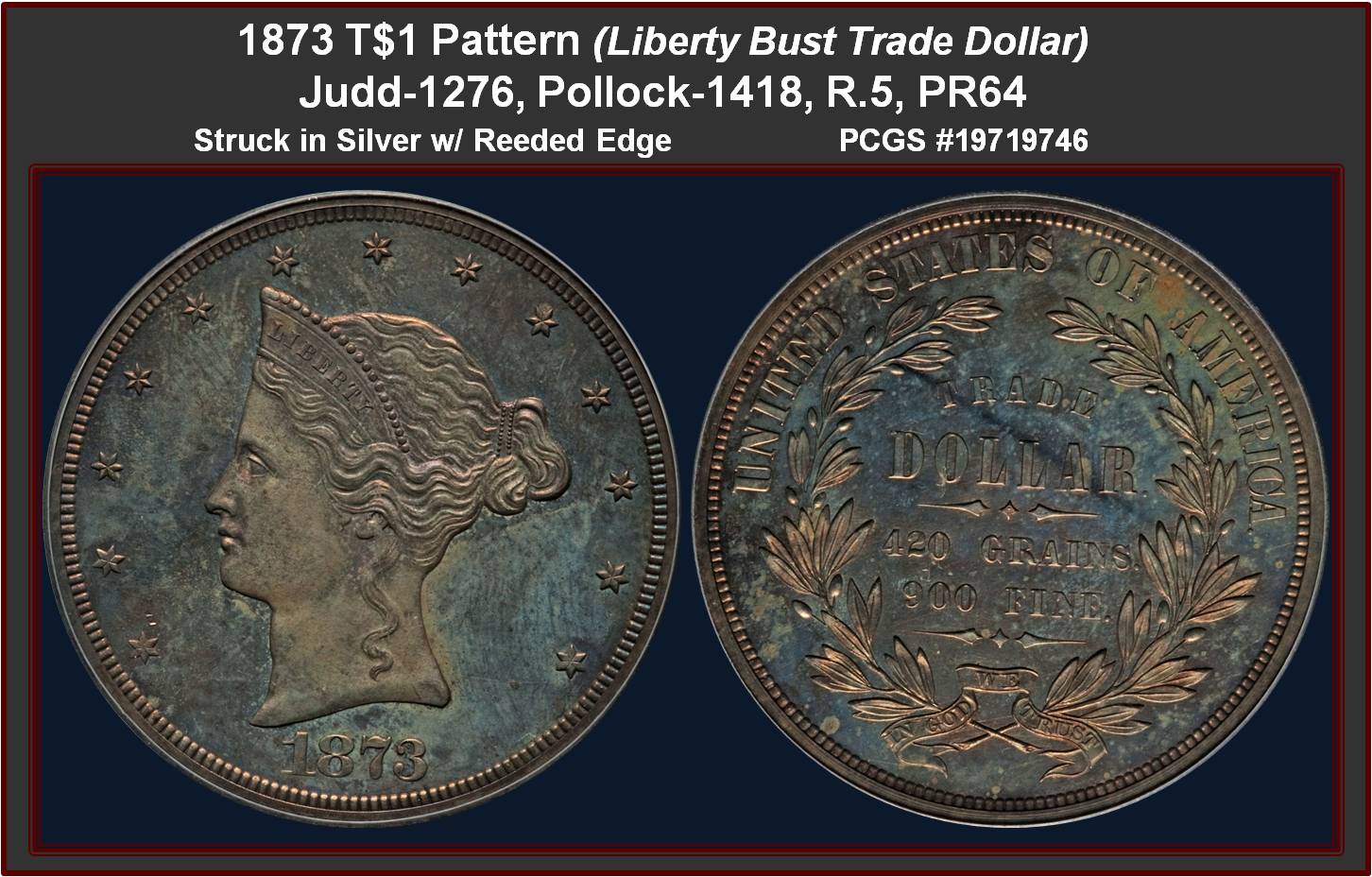
1873 1$ Trade
Judd-1276 Pollock-1418,
Rarity: R.5, (31-75 believe to be in existent), PR64
Struck in Silver with reeded edge.
Obverse: A William Barber design of the bust of Liberty facing left, with thirteen stars around and the date 1873 below. She is wearing a coronet inscribed LIBERTY and beaded along the top. Liberty's hair is tied in a knot encircled by a band of pearls.
Reverse: The denomination TRADE DOLLAR, the weight 420 GRAINS, and the quality of the metal 900 FINE, are inscribed within an olive wreath. The legend UNITED STATES OF AMERICA is above, and the motto IN GOD WE TRUST is on a scroll at the base of the wreath.
Comment: The surfaces of this piece show golden-orange patina and rose accents when held at the correct angle. Over-all nice eye appear with the even tone variations.
Provenance/ Appearances:
Heritage Mar 2016 Dallas / Lot #5158; Heritage Sept 2014 Long Beach / Lot #3581
|

|
|
View Coin
| "Baily" Head Facing Left
Standing Eagle holding shield |
United States
|
T$1 1873 J-1281
|
PCGS PF 62
|

1873 1$ Trade
Judd-1281, Pollock-1423,
Rarity: R.4, PF62
Struck in silver with a reeded edge.
Obverse: The bust of Liberty faces left on the obverse, and her hair is coiled at the back of her head. The date 1873 is below; 13 stars ring the rim.
Reverse: An eagle holds his wing open, clutching three arrows in one claw and supporting a shield with the other. A ribbon inscribed IN GOD WE TRUST transverses the shield. 420 GRAINS, 900 FINE and TRADE DOLLAR are below; UNITED STATES OF AMERICA and E PLURIBUS UNUM--the latter in minuscule font--are above.
Comment::
The Year Trade Dollars became a reality: The Bailly design, one of many in the series of 1873 Trade dollar patterns
Provenance/ Appearances:
|

|
|
View Coin
| Seated Liberty On Globe
Standing eagle Holding a Shield |
United States
|
T$1 1873 J-1293
|
NGC PF 62
|
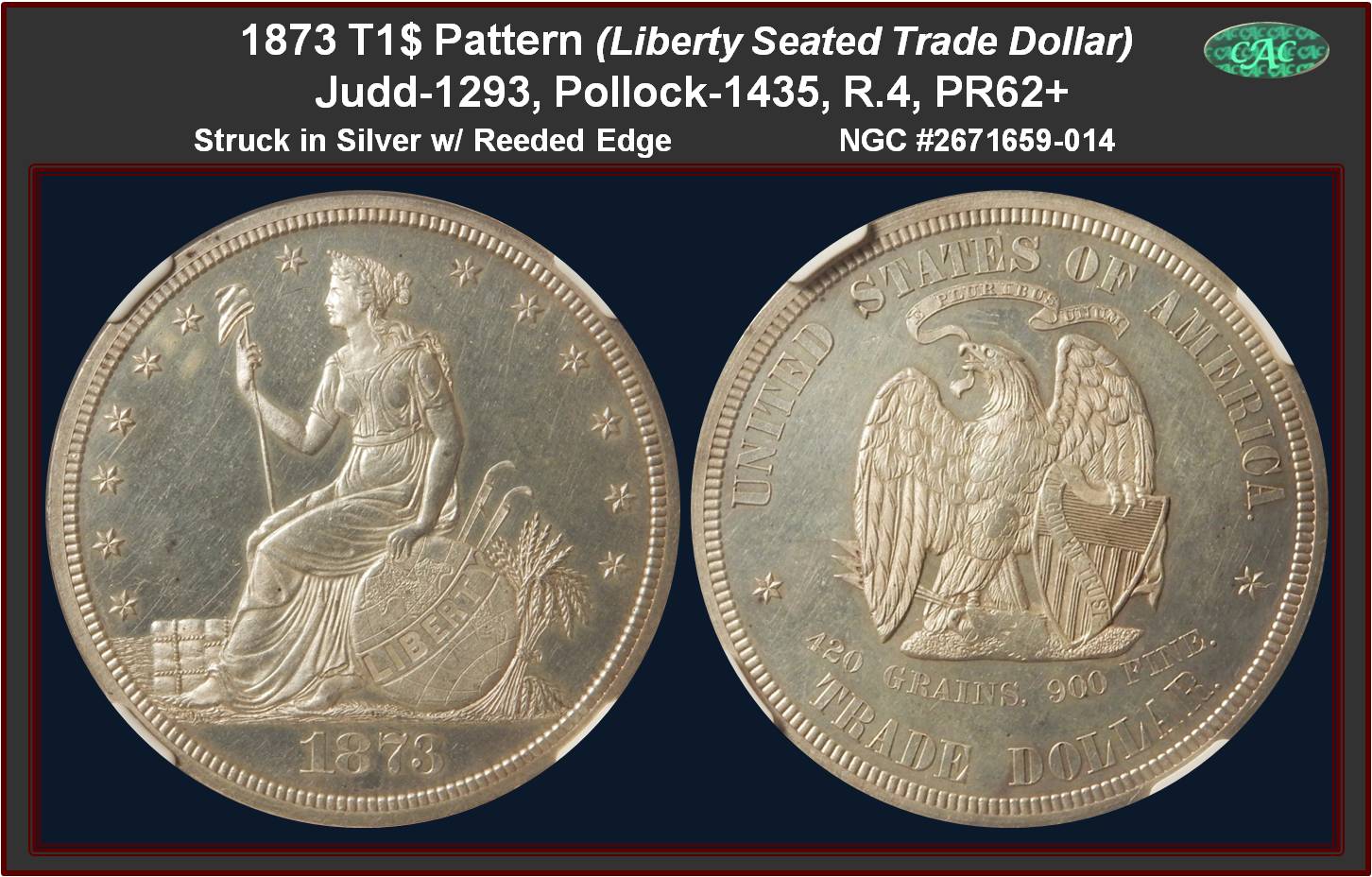
1873 1$ Trade
,Judd-1293, Pollock-1435
Rarity:R.4, PR62+ CAC Endorsed
Struck in silver with a reeded edge
Obverse: The central figure of the obverse die is a seated Liberty facing left. Liberty holds a pole with Liberty cap, and is surrounded by a globe, cotton bales, a plow, and a sheaf of wheat. There is an arc of 13 stars at the border, with the date below.
Reverse: The reverse features an eagle standing on a rock, clutching three arrows and supporting a shield with his left talon. A ribbon across the shield carries the motto IN GOD WE TRUST. A banner in the eagle's beak is inscribed E PLURIBUS UNUM. Below the eagle are the specifications 420 GRAINS and 900 FINE. The peripheral inscriptions are UNITED STATES OF AMERICA and TRADE DOLLAR.
Comment:
The piece almost has a cameo effect with lovely smooth surfaces and a slight contrast with the fields.
Provenance/Appearances:
The Kentucky Collection
.
|

|
|
View Coin
| Barber Indian Princess on Globe
Small Eagle with raised wings |
United States
|
T$1 1873 J-1310
|
PCGS PF 62
|
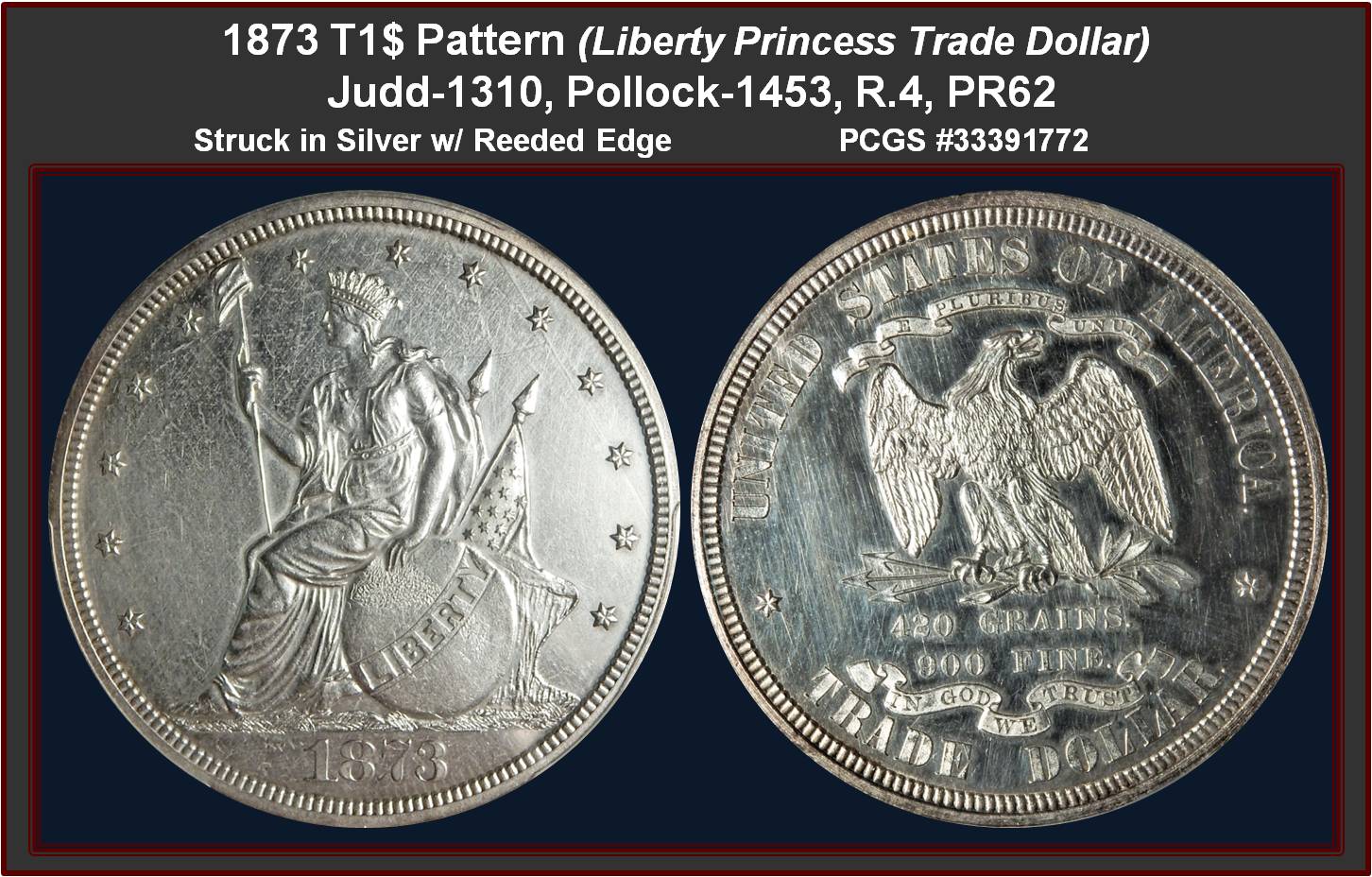
1873 1$ Trade
Judd-1310, Pollock-1453
Rarity: R.4. PR62
Struck in silver with a reeded edge.
Obverse: William Barber Trade dollar pattern shows Liberty seated on the obverse wearing an Indian headdress, Liberty pole and cap in her right hand, left hand resting on a globe, and conjoined flags behind.
Reverse: The reverse has a small eagle in the upper half with most of the statutory legends above and below, two of which are on scrolls. 420 Grains and 999 FINE are below the eagle
Comment:
the obverse design is a copy of James Longacre pattern silver dollars obverses of 1870-1872.
This design type is known is five different varieties, including reeded-edge and plain-edge pieces struck in silver, copper, aluminum, and white metal. Of the five, the silver issue with the reeded edge (Judd-1310) is the most plentiful. These were sold as part of sets to collectors for 30$
Provenance/Appearances
|

|
|
View Coin
| Baily's Seated Liberty on Globe
Small Eagle perched on Shield |
United States
|
T$1 1873 J-1315
|
PCGS PF 63 Cameo
|
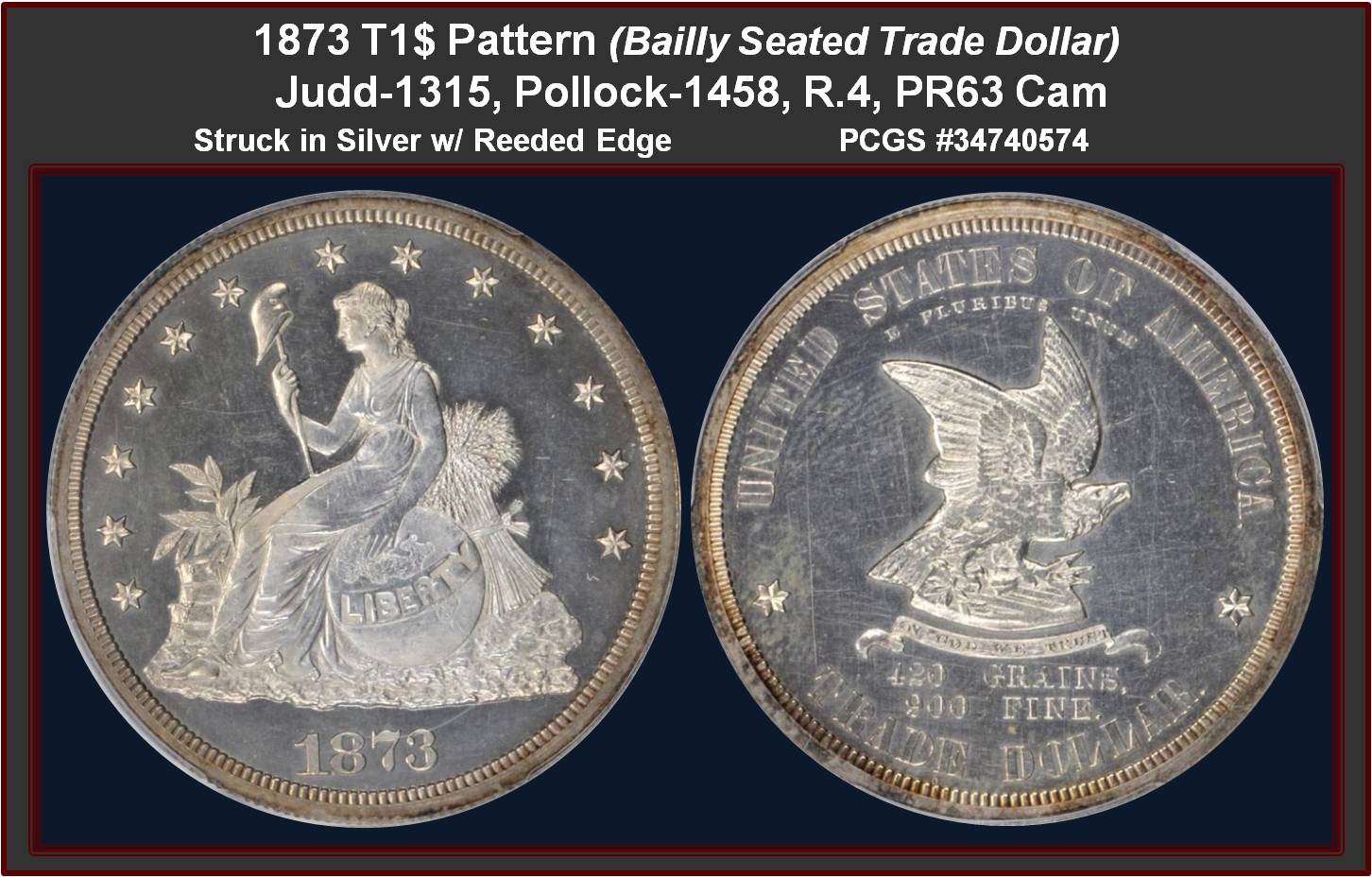
1873 1$ Trade
Judd-1315, Pollock-1458,
Rarity: R.4, PR63CAM
Struck in silver with a reeded edge.
Obverse: Bailly's Liberty design is seated left on the obverse with cotton bales, tobacco plants, and wheat sheaves around her. Her right (facing) hand supports a globe inscribed with LIBERTY while her left holds high a pileus cap.
Reverse: A small eagle atop a shield dominates the reverse with the inscriptions UNITED STATES OF AMERICA and E PLURIBUS UNUM above and 420 GRAINS, 900 FINE and TRADE DOLLAR below.
Comment:
The reeded edge variant of this pattern is by far the most obtainable of the silver, copper, and aluminum pieces struck. The fields are deeply reflective and establish the brilliant background for the frosty devices necessary for premium Cameo designation.
This design is one of the 6 pieces Trade Dollars sold in sets by the Mint
|

|
|
View Coin
| Seated Liberty on Bails facing right
Small Perched eagle with ribbon in beak |
United States
|
T$1 1873 J-1322
|
NGC PF 63
|

1873 1$ Trade
Judd-1322, Pollock-1465
Rarity R.4, PR63
Struck in Silver with Reeded Edge.
Obverse: Similar to the regular issue trade dollar design, although the right tip of the base upon which Liberty's portrait is located is longer and extends to the border.
Reverse: The reverse has a small eagle with spread wings clutches a group of three arrows in its left talon and an olive branch in its right talon. A scroll in the eagle's beak is inscribed with the Latin motto E PLURIBUS UNUM, and the inscription 420 GRAINS, 900 FINE is in the field below the eagle. The legend UNITED STATES OF AMERICA is above, and the denomination TRADE DOLLAR is below.
Comment:
With the authorization of the trade dollar, the engravers and die sinkers at the Mint prepared many sample designs for officials to inspect. The "Commercial Dollar" patterns of 1872 were followed by the trade dollar patterns in 1873; in 1873 18 different obverse and reverse die combinations were struck in various metals and edge variants, leaving a legacy of 54 different Judd numbers.
US Patterns .com indicated that this one of the types sold in6 piece sets for 30$
Provenance/Appearances:
|

|
  
 | Loading… |
|
|